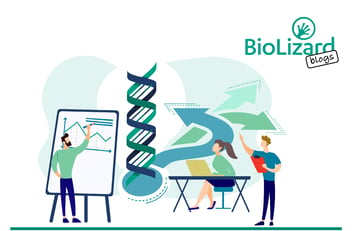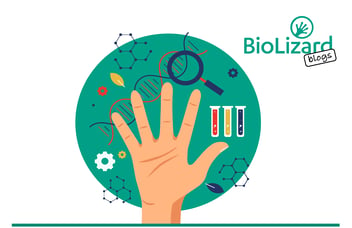Beyond diagnostics: How biomarkers can be used to de-risk drug development
Biomarker discovery is important not only in the pursuit of better diagnostics but also for de-risking drug development. By leveraging validated biomarkers, you can prioritize drug candidates with higher likelihoods of therapeutic success, thereby reducing the risk of failure in later stages of development.
Two key ways that biomarkers can help to de-risk drug development are by guiding researchers in:
- Understanding the mechanism of action
As measurable indicators of biological processes associated with diseases, biomarkers can aid in the identification of potential drug targets by pinpointing specific molecular pathways implicated in disease onset or progression. - Predicting safety & efficacy
By uncovering biomarkers that correlate with drug response, researchers can tailor treatments to specific patient populations that share the same underlying mechanisms of disease, and thus minimise the risk of adverse reactions and optimize therapeutic outcomes. In other words, biomarkers facilitate patient stratification and enable the identification of subpopulations likely to respond favorably. This personalised approach reduces the uncertainty surrounding drug efficacy and safety, leading to more efficient clinical trials and ultimately, safer and more effective medications.
Developing and validating a biomarker. Where do I start?
 Although there has been a considerable increase in scientific publications about potential biomarkers, there is still a gap in validating those biomarkers for use in clinical practice. One reason for this is that in order to develop a good biomarker, your data must be up to the test.
Although there has been a considerable increase in scientific publications about potential biomarkers, there is still a gap in validating those biomarkers for use in clinical practice. One reason for this is that in order to develop a good biomarker, your data must be up to the test.
Consider data mining
Depending on the disease area, relevant datasets for identifying appropriate biomarkers may already exist. In that case a data mining approach, in which you start by mining literature and public data resources, can be an efficient starting point for early stage biomarker discovery. For instance, there is an abundance of literature available that includes omics datasets performed for the purpose of target discovery and validation. Because these datasets often include a healthy control group and a patient group for a disease of interest, these data resources can be used to mine further differences between those two groups for the purpose of biomarker discovery.
Beware of predicting biomarker behavior in humans based on only in vitro studies or animal models
There are inherent differences that exist between species, and animals and humans demonstrate distinct variations in their physiology, metabolism, and genetics. In turn, these differences can significantly influence how biomarkers behave and respond. What may work effectively in an animal model may not necessarily translate seamlessly to humans due to the disparities that exist between species. Thus, relying solely on these methods for prediction of biomarker behavior may not provide the most accurate or reliable results.
Know your data - and make sure it’s plentiful and diverse
There’s no getting around it: to successfully validate a biomarker, you will need to include variety and diversity across your case and control groups.
Human biology is an extraordinarily complex field, and it is influenced by a myriad of variables, including environmental factors and lifestyle choices. Each of these elements, alongside characteristics like age, sex, and ethnicity, can play a part in shaping the behaviour of biomarkers in the human body. Therefore, it’s absolutely essential to enrol large enough, and sufficiently heterogeneous, study groups to ensure that you have sufficient quantity and quality of data to generate a reliable biomarker signature.
Oncology R&D: a success story in biomarker discovery & development
Biomarker discovery and development has significantly benefited oncology therapeutics and diagnostics, enhancing cancer diagnosis, monitoring of progression, and clinical treatment.
Biomarkers crucially aid in early cancer detection by serving as disease indicators even before clinical symptoms appear. A range of biomarkers are now used for this purpose, including specific genetic mutations, altered protein expressions, or changes in other molecular signatures associated with cancer. For example, commercial tests are now widely available for the detection of BRCA1/2 or BRAF mutations, which are respectively causal for breast cancer and melanoma. Early detection is essential in oncology, as it allows for intervention at earlier stages when treatment is generally more effective, thus improving patient outcomes.
Additionally, biomarkers are used in order to help refine cancer diagnosis and prognosis prediction. Clinicians can accurately classify tumours and anticipate disease outcomes by analysing molecular signatures unique to different cancer types or subtypes. This data not only informs treatment decisions, but also enables personalised patient care based on individual prognostic factors.
Finally, biomarkers guide treatment selection and monitoring for cancer patients. Clinicians use biomarkers to help determine which patients are likely to respond to certain therapies based on their molecular profiles, facilitating more personalised medicine approaches and the targeted use of specific therapies. Biomarkers also allow clinicians to monitor treatment responses and detect resistance early, enabling timely therapy adjustments to optimise patient outcomes.
Would you like to read one of our success stories? Click here to find out how we helped a client to discover two new biomarker panels & develop an automated diagnostic test with reliable ML-driven personalised risk scoring.
It’s now clear that biomarkers are a powerful tool for de-risking drug discovery & improving patient outcomes not only in oncology but across many disease areas. By providing actionable insights that guide decision-making, improve success rates, and accelerate the delivery of safe and effective therapeutics to patients, biomarker discovery plays a pivotal role in de-risking drug development.
Reach out to BioLizard today to discuss how we can help you.



